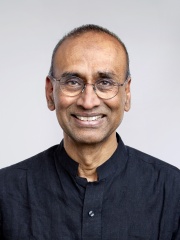
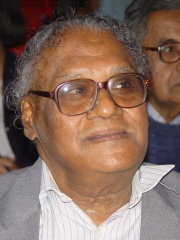
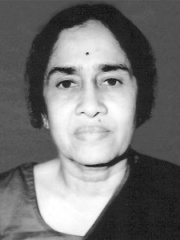
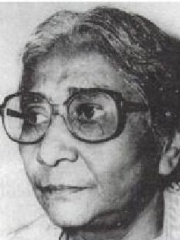
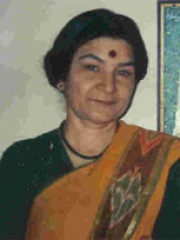
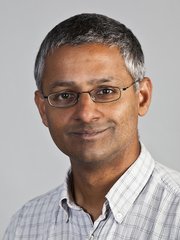
The Most Famous
CHEMISTS from India
Top 7
The following people are considered by Pantheon to be the most legendary Indian Chemists of all time. This list of famous Indian Chemists is sorted by HPI (Historical Popularity Index), a metric that aggregates information on a biography's online popularity.

1. Venkatraman Ramakrishnan (b. 1952)
With an HPI of 76.44, Venkatraman Ramakrishnan is the most famous Indian Chemist. His biography has been translated into 70 different languages on wikipedia.
Venkatraman Ramakrishnan (born 1952) is a British-American structural biologist. He shared the 2009 Nobel Prize in Chemistry with Thomas A. Steitz and Ada Yonath for research on the structure and function of ribosomes. Since 1999, he has worked as a group leader at the Medical Research Council (MRC) Laboratory of Molecular Biology (LMB) on the Cambridge Biomedical Campus, UK and is a Fellow of Trinity College, Cambridge. He served as President of the Royal Society from 2015 to 2020.

2. C. N. R. Rao (b. 1934)
With an HPI of 68.82, C. N. R. Rao is the 2nd most famous Indian Chemist. His biography has been translated into 36 different languages.
Chintamani Nagesa Ramachandra Rao, (born 30 June 1934), is an Indian chemist who has worked mainly in solid-state and structural chemistry. He has honorary doctorates from 86 universities from around the world and has authored around 1,800 research publications and 58 books. He is described as a scientist who had won all possible awards in his field except the Nobel Prize. Rao completed his BSc from Mysore University at age seventeen, and his MSc from Banaras Hindu University at age nineteen. He earned a PhD from Purdue University at the age of twenty-four. He was the youngest lecturer when he joined the Indian Institute of Science in 1959. After transferring to the Indian Institute of Technology Kanpur, he returned to IISc, eventually becoming its director from 1984 to 1994. He was chair of the Scientific Advisory Council to the Prime Minister of India from 1985 to 1989 and from 2005 to 2014. He founded and works in Jawaharlal Nehru Centre for Advanced Scientific Research and International Centre for Materials Science. Rao received scientific awards and honours including the Marlow Medal, Shanti Swarup Bhatnagar Prize for Science and Technology, Hughes Medal, India Science Award, Dan David Prize, Royal Medal, Von Hippel Award, and ENI award. He also received Padma Shri and Padma Vibhushan from the Government of India. On 16 November 2013, the Government of India selected him for Bharat Ratna, the highest civilian award in India, making him the third scientist after C.V. Raman and A. P. J. Abdul Kalam to receive the award. He received the award on 4 February 2014 from President Pranab Mukherjee at the Rashtrapati Bhavan.

3. Kamala Sohonie (1912 - 1998)
With an HPI of 65.46, Kamala Sohonie is the 3rd most famous Indian Chemist. Her biography has been translated into 31 different languages.
Kamala Sohonie (18 June 1911 – 28 June 1998) was an Indian biochemist who in 1939 became the first Indian woman to receive a PhD in a scientific discipline. Her acceptance into and work at the Indian Institute of Science, Bengaluru, paved the way for women to be accepted into the institution for the first time in its history. Her research delved into the effects of vitamins and into the nutritive values of pulses, paddy, and groups of food items consumed by some of the poorest sections of the Indian population. Her work on the nutritional benefits of the palm extract called 'Neera' was inspired by the then-president Rajendra Prasad's suggestion. Kamala Sohonie received the Rashtrapati Award for this work.

4. Asima Chatterjee (1917 - 2006)
With an HPI of 61.97, Asima Chatterjee is the 4th most famous Indian Chemist. Her biography has been translated into 51 different languages.
Asima Chatterjee (23 September 1917 – 22 November 2006) was an Indian organic chemist noted for her work in the fields of organic chemistry and phytomedicine. Her most notable work includes research on vinca alkaloids, the development of anti-epileptic drugs, and development of anti-malarial drugs. She also authored a considerable volume of work on medicinal plants of the Indian subcontinent. She was the first woman to receive a Doctorate of Science from an Indian university.
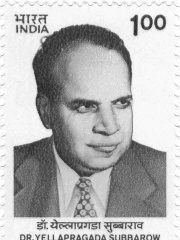
5. Yellapragada Subbarow (1895 - 1948)
With an HPI of 57.53, Yellapragada Subbarow is the 5th most famous Indian Chemist. His biography has been translated into 17 different languages.
Yellapragada Subbaroa (Telugu: యల్లాప్రగడ సుబ్బారావు, romanized: Yallāpragaḍa Subbārāvu; 12 January 1895 – 8 August 1948) was an Indian American biochemist who discovered the function of adenosine triphosphate (ATP) as an energy source in the cell, developed methotrexate for the treatment of cancer, and led the department at Lederle laboratories in which Benjamin Minge Duggar discovered chlortetracycline in 1945. A student of Madras Medical College, his elder brother and younger brother both died due to tropical sprue in the span of eight days. He subsequently discovered folic acid as a cure for tropical sprue. He discovered methotrexate, a chemotherapy drug still used today and also used for rheumatoid arthritis, and diethylcarbamazine (DEC), the only effective drug for treating filariasis. Most of his career was spent in the United States. Despite his isolation of ATP, Subbaroa did not gain tenure at Harvard University though he would lead some of America's most important medical research during World War II. He is also credited with the first synthesis of the chemical compounds folic acid and methotrexate.

6. Darshan Ranganathan (1941 - 2001)
With an HPI of 46.17, Darshan Ranganathan is the 6th most famous Indian Chemist. Her biography has been translated into 20 different languages.
Darshan Ranganathan (4 June 1941 – 4 June 2001) was an organic chemist from India who was known for her work in bio-organic chemistry, including "pioneering work in protein folding." She was also recognized for her work in "supramolecular assemblies, molecular design, chemical simulation of key biological processes, synthesis of functional hybrid peptides and synthesis of nanotubes."

7. Shankar Balasubramanian (b. 1966)
With an HPI of 39.03, Shankar Balasubramanian is the 7th most famous Indian Chemist. His biography has been translated into 14 different languages.
Sir Shankar Balasubramanian (born 30 September 1966) is an Indian-born British chemist and Herchel Smith Professor of Medicinal Chemistry in the Department of Chemistry at the University of Cambridge, Senior Group Leader at the Cancer Research UK Cambridge Institute and Fellow of Trinity College, Cambridge. He is recognised for his contributions in the field of nucleic acids. He is scientific founder of Solexa and biomodal (formally Cambridge Epigenetix).
People
Pantheon has 7 people classified as Indian chemists born between 1895 and 1966. Of these 7, 3 (42.86%) of them are still alive today. The most famous living Indian chemists include Venkatraman Ramakrishnan, C. N. R. Rao, and Shankar Balasubramanian. The most famous deceased Indian chemists include Kamala Sohonie, Asima Chatterjee, and Yellapragada Subbarow. As of April 2024, 1 new Indian chemists have been added to Pantheon including Shankar Balasubramanian.
Living Indian Chemists
Go to all RankingsVenkatraman Ramakrishnan
1952 - Present
HPI: 76.44
C. N. R. Rao
1934 - Present
HPI: 68.82
Shankar Balasubramanian
1966 - Present
HPI: 39.03
Deceased Indian Chemists
Go to all RankingsKamala Sohonie
1912 - 1998
HPI: 65.46
Asima Chatterjee
1917 - 2006
HPI: 61.97
Yellapragada Subbarow
1895 - 1948
HPI: 57.53
Darshan Ranganathan
1941 - 2001
HPI: 46.17
Newly Added Indian Chemists (2025)
Go to all RankingsOverlapping Lives
Which Chemists were alive at the same time? This visualization shows the lifespans of the 3 most globally memorable Chemists since 1700.

